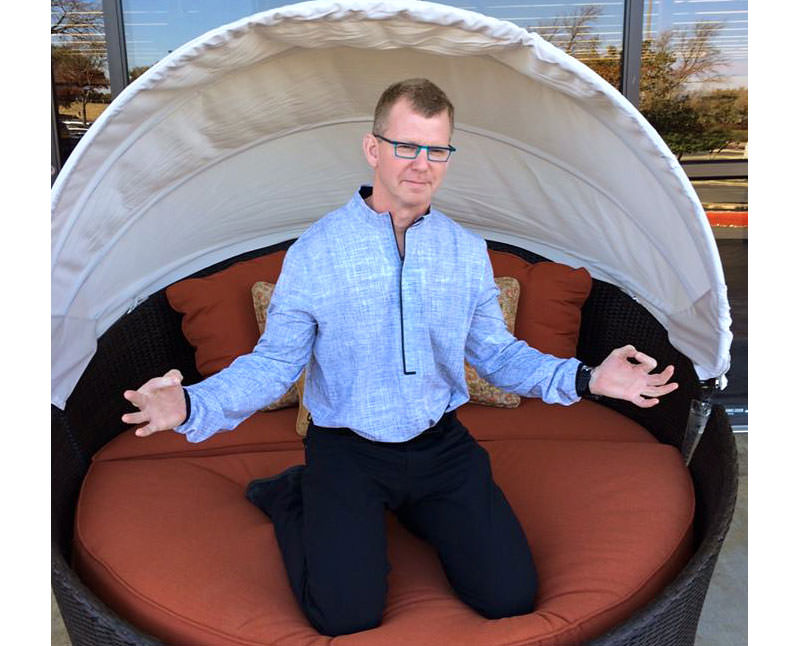Calming the Tremors of Parkinson's Disease
By Jennifer French, Neurotech Network
Being handed a card of a progressive neurological condition changes your perspective. Some neurological conditions can hit like a brick wall while others creep into your life. This story is the slow progression of Parkinson's Disease, a degenerative brain disorder that impact 7-10 million people worldwide.
The story of Dr. Jonathan Lessin, MD

As a cardiac anesthesiologist, Dr. Lessin was living his dream. He had a great job, a wonderful wife and two beautiful daughters. Although there was stress related to his job and long hours, he truly enjoyed his work.
While pouring a Coke into a glass, he observed his pinky finger quivering. That was it, a tremor. That tremor motivated Jon to seek the advice of a neurologist who was a friend of his wife's colleague. Without any hesitation, the neurologist diagnosed Jonathan with Parkinson's Disease. He was 38 years old. After receiving the news, there was a sense of relief. He was relieved to have a name associated with the strange symptoms he was experiencing.
Ironically, for all the training Jonathan received in medical school, he received very little instruction about Parkinson's Disease. During that training the focus was on tremors; no other symptoms were reviewed. Jonathan took the medical advice from his doctor and began the typical pharmaceutical regime of taking a myriad of medications.
The initial symptoms of Parkinson's Disease can be very subtle and often do not surface until the symptoms reaches an escalated level. People can have Parkinson's Disease all their lives but they do not receive a diagnosis until a larger amount of neurons in the brain begin to be impacted. At that point, the outward symptoms begin the surface.
Deep Brain Stimulation Succeeds Where Medication Fails

While his disease was progressing and impact of the medication faded, Jonathan had seen news stories on NBC's Dateline and CBS 60 minutes highlighting the Deep Brain Stimulation technology commonly used to treat symptoms of Parkinson's Disease such as tremors, rigidity, stiffness and slowed movements. DBS is a surgically implanted system consisting of three components: the electrode lead, an extension and the neurostimulator. Once the system is implanted and operational, the neurostimulator delivers electrical signals through the extension to the lead electrode. These signals or pulses to the targeted area in the brain interfere or block the abnormal nerve activity that cause tremors and other symptoms related to Parkinson's Disease.
As Jonathan began to do his research about DBS, he watched video after video on the internet about success stories of people who received a DBS system. Not all of the videos were about success stories. Jon watched one video about a man for whom the DBS was not successful and he had the device removed. In his research, Jon educated himself about the system, how it works, the surgical procedure, the complication rates and spoke with other doctors regarding the DBS technology. He approached his neurologist with an inquiry as to whether he would be a candidate for the technology. Once Jon asked, his neurologist agreed that he would be good candidate.
Jonathan also tried to continue to work but at times the symptoms were so bad he could not perform his job, even with accommodation from his employer. Instead, he was forced to take vacation time while he attempted to better manage the debilitating symptoms of Parkinson's Disease. As he became more resistant to the medications, his symptoms began to impact every aspect of his life. He was no longer able to work much less perform basic activities of daily living. For Jonathan, DBS was an option he couldn't deny. "Once I get my wires, I'll be able to function."
The Best Day of My Life

Once he received his DBS, he only wished he received it sooner. The surgery day was a significant day in Jonathan's life. Behind his wedding day and the birth of his children, getting the DBS was "the best day of my life." The DBS system gives him a new freedom of movement that was strangled by Parkinson's Disease. With his improved movement, he is able to exercise and has become healthier, regaining the weight he lost earlier. He can now eat protein and enjoys his beloved ice cream including a banana split. Sleep deprivation is a common occurrence for people living with PD. With the DBS, Jonathan can sleep more comfortably and throughout the night. There are subtle changes as well. His wife noticed the return of his facial expressions.
More dramatic is Jonathan's return to an active lifestyle. Although he retired from his medical practice, he now is an enthusiastic indoor rock climber, scaling walls three times per week. An avid skier, Jonathan was able to return to the slopes and even challenging mogul runs. He can't specifically say his performance was due to the DBS system, but he knows that he would not be able to step foot on the ski slope without the system.
To learn more about DBS and other technologies for Parkinson's Disease, visit the Neurotech Network.
About the author:
Injured but active, Jennifer French acquired her C6-7 incomplete spinal cord injury in 1998. She is an active user of a neural prosthetic system and is the first woman to receive the implanted Stand and Transfer system. Jen is a silver medalist in the sport of sailing at the 2012 Paralympic Games and is the 2012 Yachtswoman of the Year; the first woman with a disability to do so. Her story is published in her book, On My Feet Again: My Journey out of the Wheelchair using Neurotechnology. Jen is also the Co-founder and Executive Director of a 501(c)(3) non-profit organization, Neurotech Network. The organization's focus is to educate and advocate to and for persons with impairments, their caregivers and health care professionals regarding neurotechnology. For more, visit www.NeurotechNetwork.org.
Pre-Register for Abilities Expo Today...It's Free!
